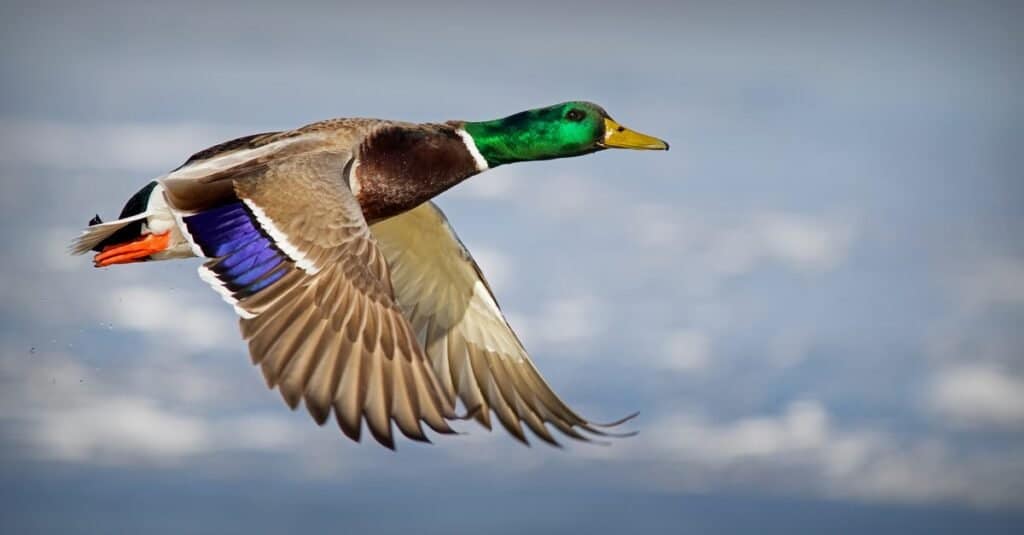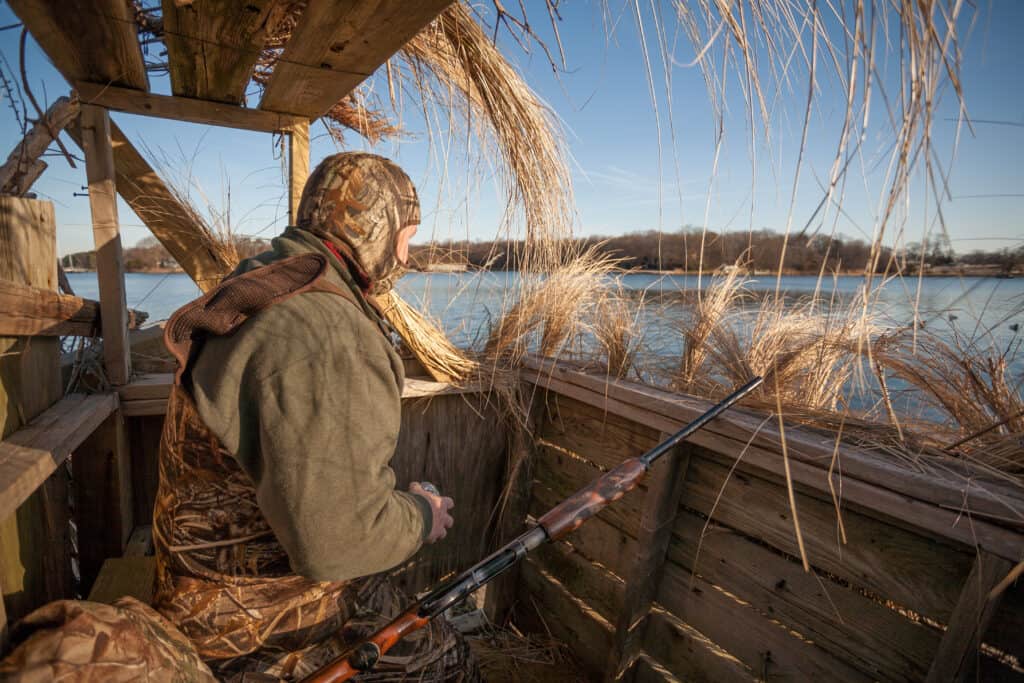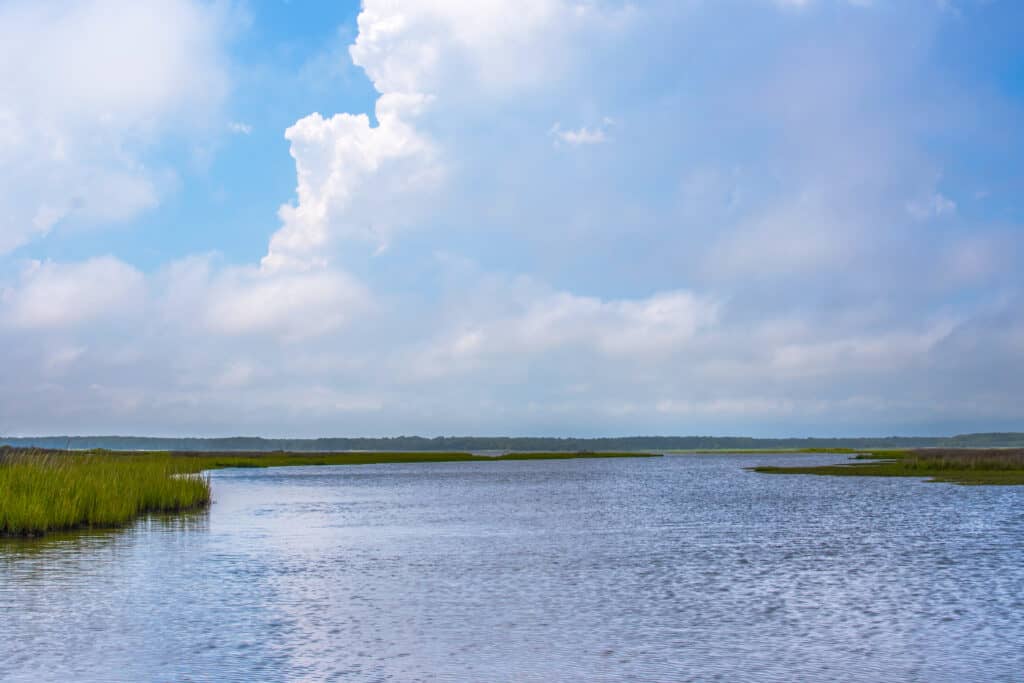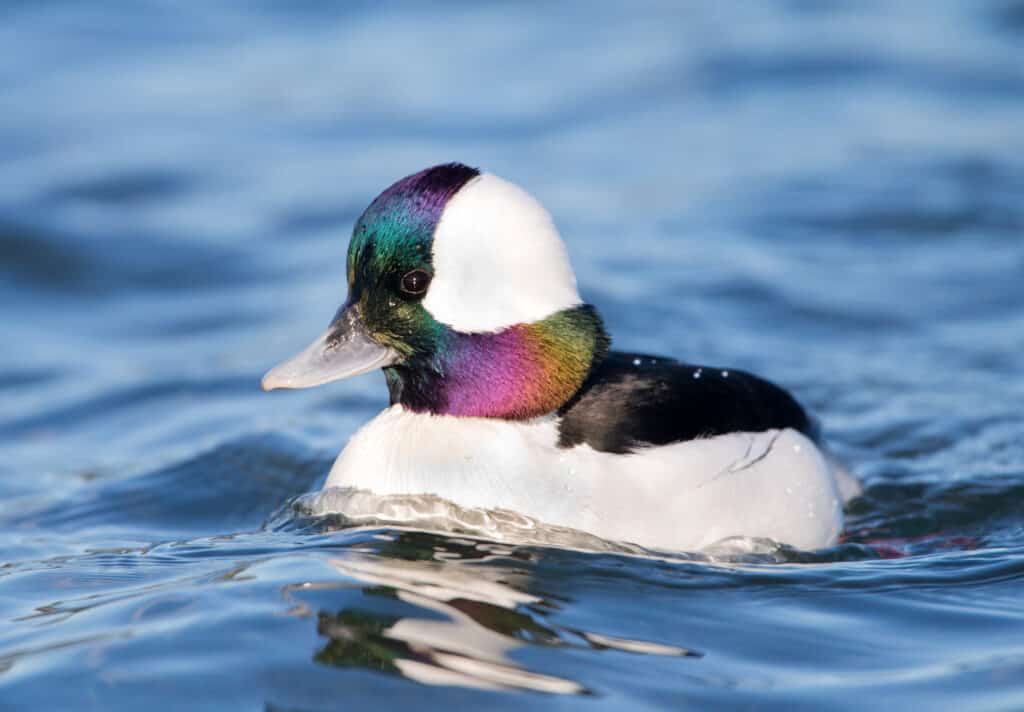It is no surprise that Maryland would have excellent duck hunting opportunities. With the Chesapeake Bay, Potomac River and the Atlantic coastline there are havens of habitat for ducks and waterfowl. Inland there are multiple Wildlife Management Areas that help maintain the ecosystem needed for resident ducks and migratory birds. If you are all geared up for duck hunting season or you are ready to try it for the first time here is everything you need to know about duck hunting season in Maryland including season dates, bag limits and more!
What Kinds of Ducks are in Maryland?

One of the common ducks in Maryland is the black duck.
©Paul Reeves Photography/Shutterstock.com
The three most common ducks harvested in Maryland are mallards, bufflehead and wood duck. Other common species include gadwalls, black ducks and green-winged teals. In the Bay you can find canvasback, scaup (bluebills), pintails and sea ducks. Out on the coast there are miles of open ocean for sea ducks like long-tails, scoters, old squaw and eiders.
Where can you Duck Hunt in Maryland?

The
Chesapeake Bay
is one of the most popular waterfowl hunting locations in the US, both for ducks and geese.
©iStock.com/flownaksala
The Chesapeake Bay is one of the most popular waterfowl hunting locations in the US, both for ducks and geese. Fishing Bay Wildlife Management Area is one of the public hunting spot on the bay. Taylors Island WMA is another one on the Bay. Sea duck hunting along the coast is popular, note that there is no longer a special sea duck season but you can hunt sea ducks during the regular duck season. You can contact one of many outfitters to find some of the best hunting or follow the guidelines and go out on your own remembering to stay at least 800 yards from all shore.
What are the Hunting Zones in Maryland?
Maryland is divided into two zones. The Eastern Zone is the area around the Chesapeake Bay and the Western Zone is the panhandle to the west.
Duck Hunting Season Dates in Maryland
| Species | Western Zone | Eastern Zone |
| Regular Duck | Oct. 1–Oct. 15 Nov. 19–Nov. 25 Dec. 15–Jan. 31 | Oct. 15–Oct. 22 Nov. 12–Nov. 25 Dec. 15–Jan. 31 |
| Black Duck | Nov. 19–Nov. 25 Dec. 15–Jan. 31 | Nov. 12–Nov. 25 Dec. 15–Jan. 31 |
| Teal (blue-winged and green-winged) | Sept. 16–30 | Sept. 16–30 |
| Sea Ducks (scoters, long-tailed duck and eiders) | Oct. 1–Oct. 15 Nov. 19–Nov. 25 Dec. 15–Jan. 31 | Oct. 15–Oct. 22 Nov. 12–Nov. 25 Dec. 15–Jan. 31 |
Other Season Dates
| West Zone | East Zone | |
| Youth Veteran and Military Wildfowl Days | Nov. 5, 2022 and Feb. 4, 2023 | Nov. 5, 2022 and Feb. 4, 2023 |
| Extended Falconry Season | Feb. 1-Mar. 10 | Feb. 1-Mar. 10 |
Bag Limits and Possession Limits for Duck Hunting in Maryland

The daily bag limit for the Regular Duck Season in both Zones is 6 ducks.
©Jeffry Weymier/Shutterstock.com
The daily bag limit for the Regular Duck Season in both Zones is 6 ducks with no more than:
2 mallards (only 1 can be a hen)
3 wood ducks
2 black ducks (Black Duck Season only)
2 canvasbacks
1 pintail
2 redheads
1 scaup per day (2 per day from Jan. 9 – Jan. 31)
1 fulvous tree duck
4 sea ducks: no more than 3 scoters, 3 long-tailed ducks, or 3 eiders (only 1 eider hen).
| Species | Bag Limits | Possession Limits |
| Ducks | 6 | 18 |
| Black Ducks | 2 | 6 |
| Teal | 6 | 18 |
| Sea Ducks (no more than 3 of each and only 1 female eider) | 4 | 12 |
What are the Shooting Hours?
The shooting hours in Maryland are ½ hour before sunrise to sunset.
Gear up! What is the Best Gear for Duck Hunting?

Today’s decoys look so real and are carefully crafted to mimic not only the coloration but the poses of common duck species.
©iStock.com/Vershinin
Having the right gear is essential to a good hunt. Here is a starter list of gear you might need for duck hunting season in Maryland:
- Shotgun: a 12 gauge or 20 gauge, can only hold three shells
- Gun case/bag/sleeve: waterproof is a must
- Shells: 3” shells are common, shot must be nontoxic
- Decoys: Today’s decoys look so real and are carefully crafted to mimic not only the coloration but the poses of common duck species. Having a spread with a dozen decoys is a good start but you can expand your spread to include more ducks and/or add in a group of geese off to the side. Some popular duck spread patterns include the fishook (or J-hook), horseshoe (or U-hook), L-spread and the X with the blind in the middle.
- Duck callers: The World Championship Duck Calling Contest is coming up Thanksgiving weekend in Stuttgart Arkansas. You don’t have to be a world champion caller to get ducks to your blind but you do have to have skill enough to help draw them in. Having a decent duck caller is an important tool but being able to use it well is even more important.
- Cooler: Plan ahead to be out all day or staying “just one more hour” as many hunters end up saying. Be sure to have enough water for the day to stay hydrated but pack enough food for the trip as well. Add in some jerky, a sandwich or two, a thermos full of chili, whatever you need for the duration of your hunt.
What is the Best Kind of Blind?

For private land you can build a permanent blind that you can use as a family and pass on to younger generations.
©Brian N Rogers/Shutterstock.com
The best kind of blind depends on the habitat you will be hunting in. For low-lying marshes you might need a layout (sleeping-bag like camouflaged blind used on the ground). If you are camped out on the shores of a river or pond an A-frame might be better. For private land you can build a permanent blind that you can use as a family and pass on to younger generations.
Boat blinds are a little different but the concept is the same. Duck boats are made for duck hunting and are great for larger hunting parties. Canoes and kayaks work great for smaller lakes, ponds and rivers. For sea duck hunting a special layout boat can help you blend in in open water.
What Should you Wear for Duck Hunting?

Duck hunting has a reputation for being gear heavy, but it doesn’t have to be.
©Scharfsin/Shutterstock.com
- Waders and Boots: Dress for the weather! Having a warm comfortable pair of boots is essential. Find a pair that is waterproof and has a warm liner, especially for late season hunting. Waders help keep you warm and dry as well so you can focus on the task at hand. They make waders with built-in boots, all one piece, or you can get separate boots and waders.
- Camo: The camo of today is photo-realistic with different fabrics to match almost any habitat. From the open sea to the reed covered marsh you can find camo to match so the ducks won’t even know you are there. For duck hunting you want everything to be camouflaged from your jacket, waders, hat even your face covering.
- Life vest or PFD: If you will be hunting from a boat, kayak or canoe be sure to wear a life vest, especially for sea duck hunting in open water. They make life vests specifically for duck hunting which don’t limit your mobility for shooting.
Hunting with your Dog

Bred to be instinctive hunting all-rounders, these multitasking dogs can hunt, point, and retrieve, and have been used to hunt quarry of all kinds, including rabbits, raccoons, game birds, and even deer.
©iStock.com/slowmotiongli
Taking the time to train you pup as a hunting dog can be a rewarding experience. Working together in the field is an enjoyable way to get out in nature. Some dog breeds live to hunt and look forward to spending days in the field with their owners. Common dog hunting breeds include Labrador retrievers, golden retrievers, pointers and spaniels. When it comes time for the hunt be sure to have an insulated dog vest for your dog and bring a leash to keep them contained during transitions. Remember to always have a first aid kit with dog specific items as well.
Factors for Success
Three of the biggest factors for success are your blind location, your decoy spread and the weather. You can scout out locations for hunting well before opening season. It also makes sense to visit the site just a few days before your hunt to scope out the vegetation status, the water levels and the number of waterfowl currently present. Have your decoys picked out well in advance and know what spread pattern you will use depending on the wind for the day. You can’t do much about the weather but you can be prepared by checking the forecast a few days before the big day. Fall in Maryland can provide the perfect weather recipe for duck hunting, cool, wet, windy and overcast.
Where are the Best Places to Duck Hunt in Maryland?

For sea duck hunting review the Sea Duck Zones to know where duck hunting is allowed. The rule of thumb is you must be at least 800 yards off shore.
©Charles Goudy/Shutterstock.com
The best places to hunt in Maryland are the Chesapeake Bay and along the Atlantic Coast. In the Chesapeake, much of the shoreline is privately owned but there are a couple excellent WMA that allow hunting. The Fishing Bay WMA and Taylors Island WMA both have public area for waterfowl hunting. For sea duck hunting review the Sea Duck Zones to know where duck hunting is allowed. The rule of thumb is you must be at least 800 yards off shore.
Meet the Species: 3 of the Most Common Ducks in Maryland

The peak of the bufflehead migration is in November.
©Birdiegal/Shutterstock.com
- Mallard: Sometimes called greenheads due to the bright iridescent green heads of the males, these are the most common duck in North America. The males also have a classic yellow beak and orange legs.
- Bufflehead: The peak of the bufflehead migration is in November. The back feathers on this duck are black with a mostly white body. The heads of the males are greenish-black with a white patch on the back of their heads. Buffleheads can be found in the Chesapeake Bay area.
- Wood duck: Some of the most colorful ducks the male wood ducks have a colorful head with the top of their head being iridescent green that fades to blue. Their eyes are red and they have an orange streak behind their bills. Black and white markings highlight their head and their wings. Some wood ducks migrate through Maryland while others live there year round.
Up Next
Thank you for reading! Have some feedback for us? Contact the AZ Animals editorial team.








